Bear Viewing
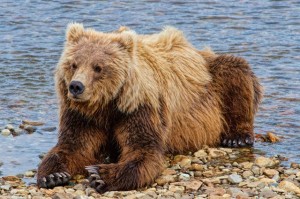 Brown and Grizzly Bears (Ursus acrtos) are classified as the same species and are genetically identical even though there are notable differences between them. “Brown bears” typically live along the southern coast of the state where they have access to seasonally abundant spawning salmon. The coastal areas also provide a rich array of vegetation they can use as food as well as a milder climate. This allows them to grow larger and live in higher densities than their “grizzly” cousins in the northern and interior parts of the state. Brown bear sizes can vary greatly by gender, age, location, and time of year.
Brown and Grizzly Bears (Ursus acrtos) are classified as the same species and are genetically identical even though there are notable differences between them. “Brown bears” typically live along the southern coast of the state where they have access to seasonally abundant spawning salmon. The coastal areas also provide a rich array of vegetation they can use as food as well as a milder climate. This allows them to grow larger and live in higher densities than their “grizzly” cousins in the northern and interior parts of the state. Brown bear sizes can vary greatly by gender, age, location, and time of year. 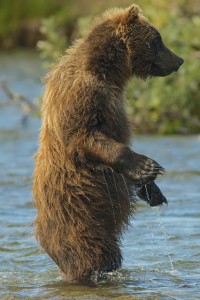 Weighing only one pound at birth, an adult male may weigh up to 1,500 lbs in coastal areas, and tend to be 30-50% larger than females. Bears weigh the least in the spring when they come out of their dens. They can increase their weight by 50% in late fall and summer. Mating season is from May to July, and cubs are born in the den during January and February when they emerge from the den in the spring they will weigh only 15 lbs. Twins are quite common, but litter sizes may vary from 1 to 4.
Weighing only one pound at birth, an adult male may weigh up to 1,500 lbs in coastal areas, and tend to be 30-50% larger than females. Bears weigh the least in the spring when they come out of their dens. They can increase their weight by 50% in late fall and summer. Mating season is from May to July, and cubs are born in the den during January and February when they emerge from the den in the spring they will weigh only 15 lbs. Twins are quite common, but litter sizes may vary from 1 to 4.
Katmai and Lake Clark National Park provide some spectacular opportunities for bear viewing. Whether the popular “Brooks Falls”, or a more remote wilderness area, watching and photographing Brown Bears in their natural environment is exhilarating.
Alaskan Wildlife Tours
A variety of other wildlife can be found nearby, Black Bear, Caribou, Moose, Dall Sheep, Pacific Walrus, Bald Eagles, Willow Ptarmigan
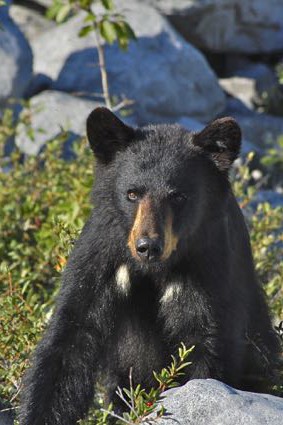 Black bears (Ursa Americanus) are primarily a solitary animal, with the exception of a sow with cubs and during the mating season of June and July. They are the most widely distributed of the three species of North American bears. The smallest species of bear in Alaska, Adults stand about 29 inches at the shoulders and are about 60 inches from nose to tail. Males weigh about 180-200 pounds in the spring and may be around 20% heavier in the fall prior to hibernation. They can be seen eating berries and roaming the hillsides surrounding Port Alsworth and throughout Lake Clark National Park and Preserve.
Black bears (Ursa Americanus) are primarily a solitary animal, with the exception of a sow with cubs and during the mating season of June and July. They are the most widely distributed of the three species of North American bears. The smallest species of bear in Alaska, Adults stand about 29 inches at the shoulders and are about 60 inches from nose to tail. Males weigh about 180-200 pounds in the spring and may be around 20% heavier in the fall prior to hibernation. They can be seen eating berries and roaming the hillsides surrounding Port Alsworth and throughout Lake Clark National Park and Preserve.
The only species of the deer family in which both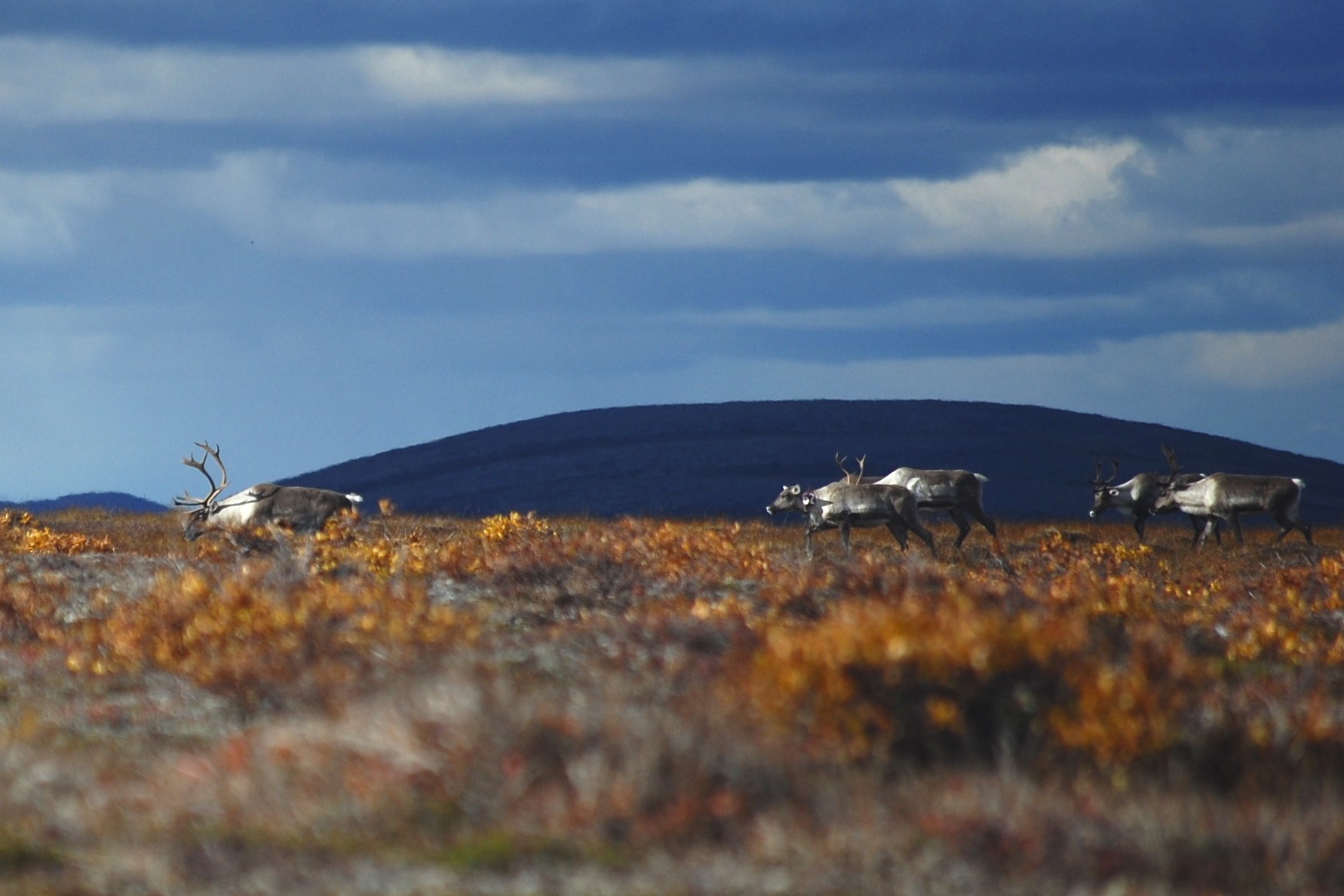 sexes grow antlers, the Caribou (Rangifer tarandus granti) prefer treeless tundra and mountains during all seasons, but many herds winter in the boreal forest (taiga). Barren Ground Caribou, one of 7 subspecies of Caribou, are predominately found in Alaska. Caribou in Alaska are distributed in 32 herds or populations. A herd uses a distinct calving area that is separate from the calving area of other herds, but different herds may mix on winter ranges.
sexes grow antlers, the Caribou (Rangifer tarandus granti) prefer treeless tundra and mountains during all seasons, but many herds winter in the boreal forest (taiga). Barren Ground Caribou, one of 7 subspecies of Caribou, are predominately found in Alaska. Caribou in Alaska are distributed in 32 herds or populations. A herd uses a distinct calving area that is separate from the calving area of other herds, but different herds may mix on winter ranges.
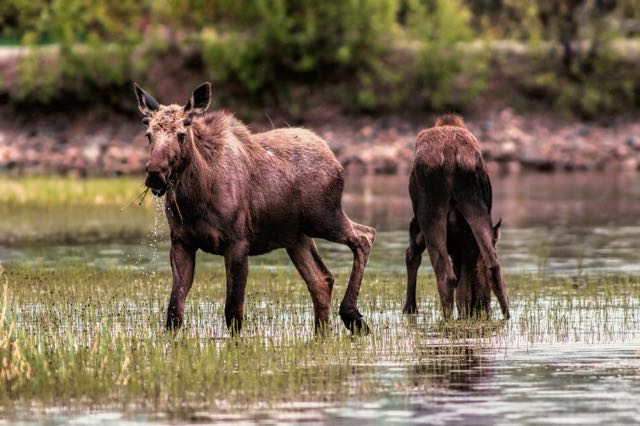 Moose (Alces alces) are the largest of the deer family. Adult moose can range in size from 800 pounds for a small adult female to 1,600 pounds for a large adult male, and they can be up to almost 6 feet tall. Moose consume large quantities of birch, willow, and aspen twigs during the fall and winter, adding vegetation in shallow ponds, forbs, and leaves to their diet in the summer months. The males or “bulls” grow large antlers every summer, the largest antlers are usually grown when a moose is 10-12 years old. Moose rarely live past 16 years of age.
Moose (Alces alces) are the largest of the deer family. Adult moose can range in size from 800 pounds for a small adult female to 1,600 pounds for a large adult male, and they can be up to almost 6 feet tall. Moose consume large quantities of birch, willow, and aspen twigs during the fall and winter, adding vegetation in shallow ponds, forbs, and leaves to their diet in the summer months. The males or “bulls” grow large antlers every summer, the largest antlers are usually grown when a moose is 10-12 years old. Moose rarely live past 16 years of age.
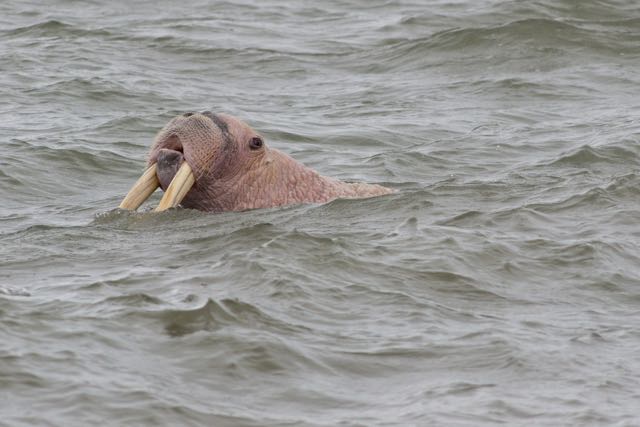 A large pinniped that lives in the Bearing and Chukchi seas, the Pacific Walrus (Odobenus rosmarus divergens) are highly social animals that rest and travel in large groups. Walruses will commonly rest on rocks, sandy beaches, or grassy hills, when sea ice is not available. This provides opportunity to form large social haulouts that can contain thousands of individuals. Adult males, or bulls, are up to 12 feet long and may weigh up to 2 tons. The females can weigh more than 1 ton. Both male and female have ivory tusks. Walrus mate in the water during the January through March. Delayed implantation suspends development of the fertilized egg for several months resulting in a gestation period of 15 months. Walrus feed on a variety of soft invertebrates found on or below the seafloor. They use their sensitive whiskers to search for prey.
A large pinniped that lives in the Bearing and Chukchi seas, the Pacific Walrus (Odobenus rosmarus divergens) are highly social animals that rest and travel in large groups. Walruses will commonly rest on rocks, sandy beaches, or grassy hills, when sea ice is not available. This provides opportunity to form large social haulouts that can contain thousands of individuals. Adult males, or bulls, are up to 12 feet long and may weigh up to 2 tons. The females can weigh more than 1 ton. Both male and female have ivory tusks. Walrus mate in the water during the January through March. Delayed implantation suspends development of the fertilized egg for several months resulting in a gestation period of 15 months. Walrus feed on a variety of soft invertebrates found on or below the seafloor. They use their sensitive whiskers to search for prey.
